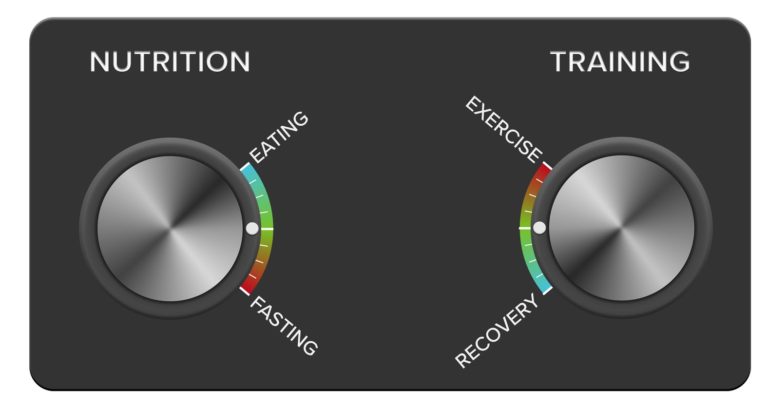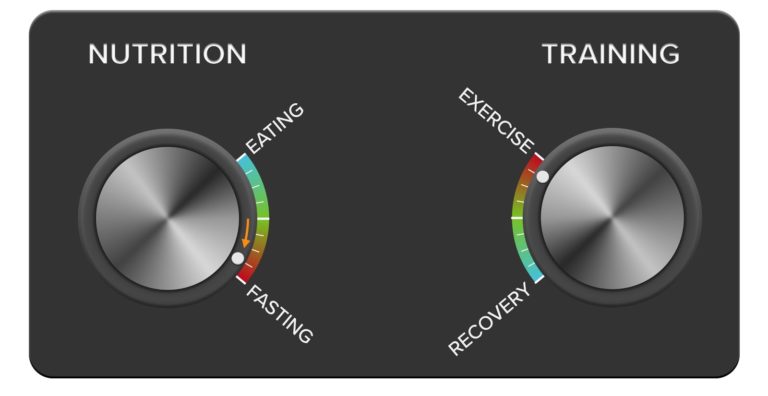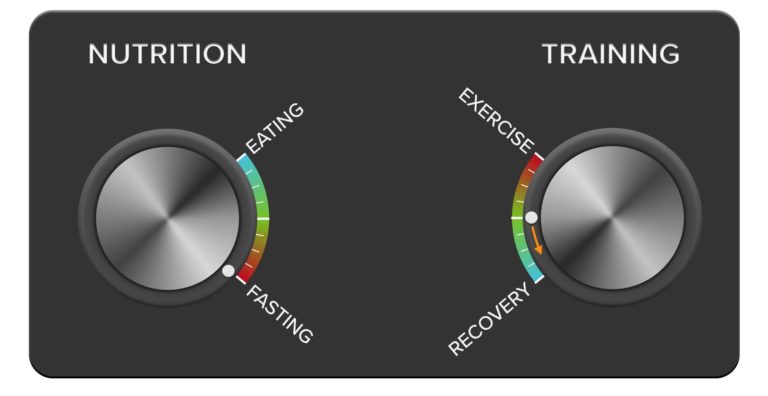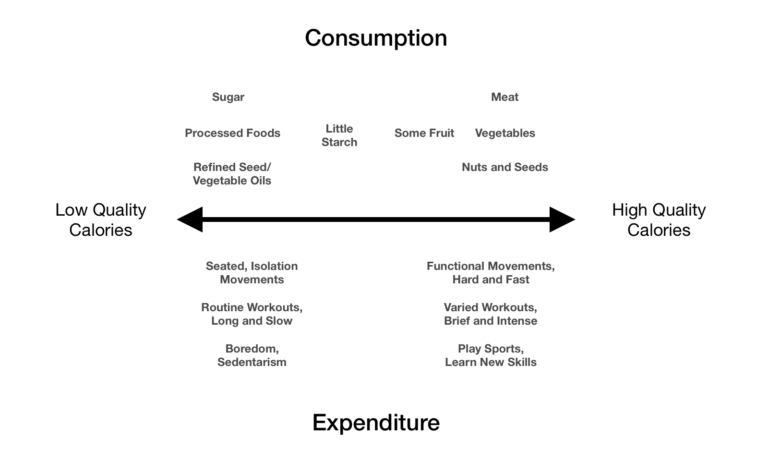The energy balance hypothesis suggests you can achieve perfect health by counterbalancing nutrition choices with physical activity; “calories in, calories out” is a popular motto among proponents of this model for nutrition and exercise.
The hypothesis has enjoyed popularity among public health organizations and large food corporations. In fact, sometimes the two groups work together on initiatives, such as Exercise Is Medicine, to promote the idea that we need to “eat less and move more.” Such arrangements are mutually beneficial, because they allow public health groups to deflect attention from their flawed nutrition guidelines and allow Big Food to keep selling junk food with a clean conscience. Unfortunately, the energy balance model perpetuates dangerous myths about nutrition and exercise. So what is the truth about how to dial in these two mechanisms for improving health?
Nutrition and Exercise as Opposing Forces
Training and nutrition are the two most powerful mechanisms for improving human health, but they exert their influence from opposite directions. Diet supplies energy and is the source of the body’s structural components. Exercise consumes energy and actually breaks down the body in various ways. Our muscles, tendons, and even bones are damaged during exercise, but they grow back stronger in response to the stress. These adaptations, not the stress, are what we’re chasing when we exercise.
Let’s imagine diet and exercise as two dials that can be set from zero to 10. By manipulating these dials, we can achieve a variety of effects. It would please Big Soda greatly if we would all increase our consumption of their sugary products and then burn off the calories. We could go even further and live the life of an Olympic athlete. At peak training, some athletes consume over 10,000 calories a day, or quadruple that of the average person. Extraordinarily high training volumes keep their body weight steady, but this diet and exercise pattern does not provide a viable long-term plan for good health.
 Eating puts your body into a growth state, which is essential for life and development. However, we live in a world where many people have this dial permanently turned up, and the result is an obesity epidemic. Much of the problem can be traced to poor quality food, which leads to metabolic derangement and frequent eating.
Eating puts your body into a growth state, which is essential for life and development. However, we live in a world where many people have this dial permanently turned up, and the result is an obesity epidemic. Much of the problem can be traced to poor quality food, which leads to metabolic derangement and frequent eating.
Fasting refers to any time when one abstains from eating. Time spent fasting allows the digestive system to recover. It also serves as a form of training for the body’s metabolism. However, turning the dial toward fasting for too long can cause a loss of muscle mass and a reduced metabolic rate. In an underfed state, your body temperature will drop. Perhaps surprisingly, people in an underfed state also move slower, speak slower, and even blink slower.
Exercise is an essential stimulus for general health. Like fasting, it challenges our metabolism, but unlike fasting, it can build muscle and strengthen bones. The metabolic challenge comes from dramatically increasing energy expenditure, forcing our bodies to adapt to supply our muscles with more energy.
Recovery is an essential part of the training process. There is a saying that “there is no such thing as overtraining, only under-recovery.” This is likely true in many cases but not all. Rhabdomyolysis can occur when a person overtrains to the point that severe muscle damage poisons the body. On the flip side, some people could say they are “over-recovered,” but really that would just be a misnomer for sedentary behavior.
Fine-Tuning the Dials
You might think the ideal would be to have each dial set exactly in the middle. On average that might be true, but some amount of oscillation is necessary. Many people become obese without ever binging, instead simply snacking a bit all day every day. Their eating pattern is not balanced with either fasting or exercise. Likewise, continuous activity is not a great training stimulus, because it must remain low-intensity for it to be performed constantly.

Exercise gradually shifts the nutrition dial down as energy is consumed. As glycogen stores diminish, utilizing stored body fat becomes more important. Starting a training session in a low-glycogen or fasted state requires further fat adaptation.
It is very tempting to overthink the tuning of these dials. Keep in mind, they only amplify whatever inputs enter the system. The first priority should always be high-quality food and exercise. A well-tuned junk food diet is still a junk food diet. With a high-quality diet and training program, the fine-tuning of these dials does not need to be complicated and self-regulates to a large degree. Quality food satisfies your appetite, making you less hungry and less likely to overeat. You can go remarkably far just listening to your body. Eat when you’re hungry, don’t when you’re not. Train hard when you feel great and back off a bit when you don’t. It takes a lot of skill and effort to beat the body’s own feedback systems and is largely a pursuit for elite athletes.
Breaking the Dials
If the nutrition dial is turned all the way down to zero, we end up in a prolonged fasted state. Fasting has many health benefits, such as lowering blood glucose and insulin, cleaning up damaged proteins and cellular debris (autophagy), and flipping the metabolic switch to fat burning. Of course, there is a limit to how far one can go with fasting.

Fasting reduces caloric intake to zero. Short-term fasts have a minimal impact on activity levels, but prolonged fasts eventually reduce basal metabolic rates and exercise quality.
The world record for fasting is 382 days with only water, tea, coffee, and some supplements. The patient began the fast at 456 lb. and leaned down to 180 lb. A typical person cannot survive nearly this long without food. According to starvation studies, death typically occurs when the body runs out of muscle, as muscle provides the key protein store in the body and is used to synthesize glucose. Most people will want to balance out the positives of fasting with the negatives, such as lost muscle mass and the risk of refeeding syndrome.
How much muscle you lose on a fast depends largely on the amount of body fat you have stored. During a prolonged fast, an obese person can meet 94% of their energy needs through oxidation of stored body fat, whereas a thin person can only supply 78% of their energy from stored fat. The remainder comes from the breakdown of protein.
There is surprisingly little information available on muscle loss during extended fasting. A 1975 study reports lean body mass drops initially at a rate of .75 lb. per day at the onset of a fast and drops to .25 lb. per day by day 30. This drop in lean body mass is not entirely muscle loss, though. People with higher initial levels of body fat will lose less lean mass, and women tend to spare lean mass more effectively than men. As Dr. Jason Fung points out:
We don’t waste away our muscle while keeping all our fat stores. … During fasting, hormonal changes kick in to give us more energy (increased adrenaline), keep glucose and energy stores high (burning fatty acids and ketone bodies), and keep our lean muscles and bones (growth hormone).
Briefly turning the nutrition dial to zero has potential health benefits and an impact on lean body mass that is quickly reversible. Studies on shorter fasts of 24-36 hours and time-restricted eating patterns that involve fasting for 18 hours and eating for six hours daily have both been shown to spare lean mass while reducing fat mass. Most healthy people not looking to increase body mass should experiment with their feeding/fasting window, but many of the health benefits of fasting overlap with the health benefits of fitness.
We’ve looked at what happens when you dial nutrition all the way down to zero, but what about the training dial? Bed rest studies offer us a clue to what an “exercise fast” looks like. Andrew Iwanicki wrote of his experience standing up for the first time after 70 days of bed rest:
As soon as the bed was tilted to the vertical position, my legs felt heavier than ever before. My heart started to beat at 150 BPMs. My skin became itchy; I was covered in sweat. … Around the eight-minute mark, my pulse dropped from 150 down to 70. My body was about to collapse. As my vision started to go black, the staff saw my numbers drop on the machines and promptly returned the bed to the horizontal position. It was only later that they told me that none of the NASA bed-rest subjects have lasted the full 15 minutes.
When confined to a bed, a person’s physical capacity declines rapidly. Muscle loss of 1.4 kg has been observed in healthy young men after only seven days of bed rest, and 1.5 kg of loss occurred in healthy older men after 10 days. Equally worrisome is the development of insulin resistance and substantial decreases in lower body strength and aerobic capacity. These bed rest studies have implications for prolonged space flight, where microgravity removes the stress of carrying your own body weight.
Of course, resting is essential to high-performance athletes. A lack of sleep can have a profound impact on recovery from training and even on metabolic health. One study showed a single week of impaired sleep (five hours/night) reduced the insulin sensitivity of healthy young men by 11%. Hard-training athletes generally need more sleep, but needs vary between individuals. If your training is not delivering the adaptations you expect, it’s worthwhile to examine your sleep habits. Adaptation does not happen during a workout but during recovery.
Making Every Calorie Count
If you’re not experiencing the adaptations you expect, it is also worthwhile to examine your nutrition, which provides the building blocks your body needs to recover.
The energy balance approach to nutrition and exercise ignores the clear differences between protein, carbohydrates, and fat; it also doesn’t account for the difference between processed and whole foods. It perpetuates the myth that you can achieve optimal health by carefully balancing your caloric intake and expenditure, but extensive research has shown some nutritional calories are better than others. This series has argued that some forms of exercise are calorie-for-calorie better than others. The key is exercising with intensity, variety, and functional movements, as we do with CrossFit.

CrossFit is designed to provide the most adaptation for the least amount of input. In that sense, it is a minimalist approach to maximum fitness. There should be room left for another sport, a physical occupation, or even more training if you want to compete in the CrossFit Games. This high-quality exercise should be paired with a high-quality diet. Otherwise, you are working hard for suboptimal results.
CrossFit places nutrition at the base of the hierarchy of athletic development, because nutrition provides the metabolic and structural foundation for the body. Exercise comes next, because it is the chisel that sculpts the raw material of your diet into form. Would you give Michelangelo a lump of coal and expect to see David?